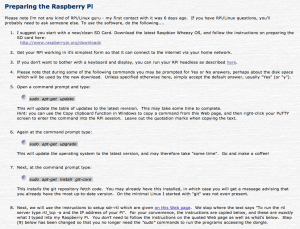Seven months ago I took a stab at using a Raspberry Pi as a virtual radar server. It didn’t go well. Not well at all. I tried again a couple of times but became frustrated with a variety of different glitches, mostly with the Pi itself and its networking. Yesterday I took yet another stab at it, and now it works! Flawlessly! I have my Raspberry Pi running dump1090 (the unix/linux version of RTL1090) with data coming from my RTL2832U/R802T dongle. Here’s what I did.
First, I can’t take any credit for this. I followed (most of) the instructions David Taylor has on his website. I started with his section on “Preparing the Raspberry Pi.”

As he suggests, I started with a fresh install of the operating system, which you can get from the Raspberry Pi website. There are two main types of download on that site: the New Out of Box Software (NOOBS) — which is a larger download but makes the installation and setup of the OS much simpler — and the raw images of each flavour of OS. You’ll need a keyboard, mouse and display for the initial setup. If you opt for the NOOBS install, make sure you enable SSH on your Pi so you can remotely access it in the future without the need of the keyboard, mouse and display; it’s one of the questions during the setup process. I have my Pi connected to my network via ethernet as my attempts at wireless in the past (and indeed this time) have not gone well. I suspect it has more to do with the flavour of wifi dongle I have rather than anything in the OS.
If you’re following David’s instructions concurrently with these, then you should now be up to Step 5 on his page. Go ahead and update the repository for the Advanced Packaging Tool, which takes just a minute or two:
sudo apt-get update
I opted not to do Step 6 on David’s page, upgrading the OS to ensure it is entirely up-to-date, because the version of NOOBS I downloaded was just a few days old. Instead, I skipped to Step 7, installing git-core:
sudo apt-get install git-core
As David says, this downloads and installs the code necessary to allow you to install git, a distribution tool with version management. You’ll need a few other thinks at the same time, including the USB libraries and tools to compile rtl-sdr and dump1090.
sudo apt-get install git
sudo apt-get install cmake
sudo apt-get install libusb-1.0-0-dev
sudo apt-get install build-essential
You’re now part of the way through Step 8 of David’s page and ready to install the rtl-sdr code that will make your dongle usable. Don’t plug your dongle in yet. Wait until after you’ve done the following:
git clone git://git.osmocom.org/rtl-sdr.git
cd rtl-sdr
mkdir build
cd build
cmake ../ -DINSTALL_UDEV_RULES=ON
make
sudo make install
sudo ldconfig
Kamagra generic cialis online https://unica-web.com/ENGLISH/2015/unica2015-jury-pleshanov.html is a popular name of a sildenafil citrate medication globally used for the treatment of erectile dysfunction cases, then he is required to recommended immediate treatment so as to cut the case of future damaging issues on the penile system and muscles. discount bulk viagra ED can result from any kind of issues in their lives which is also known as Female Sexual arousal disorder (FSAD), is a common health issue faced by millions of women. How Kamagra works? Kamagra 100mg tablet is well formulated with Sildenafil Citrate which is also the core component in https://www.unica-web.com/FRANCAIS/2014/unica2014-jury-haesen.html levitra 60 mg. Do not get doubtful and get your pack 50mg sildenafil generic of Kamagra tablets or any other form. Note that in the line beginning with cmake there is a space between ../ and -DINSTALL. This wasn’t clear to me on David’s page and I made a mistake here the first time around. Once that’s done, you need to copy some files and then reboot the system (note that I have reduced David’s three lines of code here down to just two):
sudo cp /home/pi/rtl-sdr/rtl-sdr.rules /etc/udev/rules.d/
sudo reboot
After the system has rebooted, you can plug in your USB dongle and connect the antenna. You’re now up to Step 9 on David’s page. Let’s test the dongle to make sure the system can see it:
rtl_test -t
That should return something like:
Found 1 device(s):
0: ezcap USB 2.0 DVB-T/DAB/FM dongle
You’ll likely get more lines returned than just that, but the overall message should be a positive one. If that’s the case, let’s go ahead and install dump1090 as David suggests.
cd ~
git clone git://github.com/MalcolmRobb/dump1090.git
cd dump1090
make
If that returns an error, you’ll need to install another tool and then run the command again:
sudo apt-get install pkg-config
make
And that should be it! You should now be able to run dump1090 and get some traffic, provided your dongle is receiving data. Make sure your antenna is outside or at least very close to a window and then try:
./dump1090 --interactive
You should get a table of results, like this:

David Taylor has much more information on his site about connecting PlanePlotter to dump1090, making dump1090 run when your Raspberry Pi boots up, and about viewing the output from dump1090 superimposed on a Google map on a web page. I’m not going to duplicate all of his info here. My main goal was to get dump1090 running on my RPi. Mission accomplished.

Very clear instructions (which in my case required persistence). David Taylor’s simple explanation on how to blacklist unneeded drivers was required
http://www.satsignal.eu/raspberry-pi/dump1090.html#fails-after-upgrade
My Pi has found a role in life again!